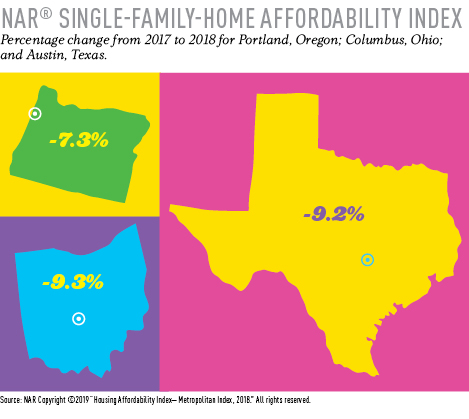Some U.S. markets are revising zoning and land-use rules to create opportunities for more mixed-use housing development
By Regina Ludes
A typical neighborhood in the early 20th century had a mix of housing types in walkable, urban areas—duplexes, three-flats and courtyard buildings. But construction of those properties declined as zoning regulations became more restrictive in favor of single-family homes. Today’s communities are paying the price with few mixed-housing options available that are affordable for most Americans.
According to a September 2019 survey by the National Association of Home Builders, 75% of residents believe housing affordability is a huge issue in their city. Further, 52% say they would support reducing zoning regulations and permit procedures that increase construction costs. Such public pushback is putting pressure on city officials to rethink development rules to allow for more multi-unit housing options. In addition, rising population, buyer demand and improved transit systems have increased the need for more and better housing options. While some jurisdictions are revising zoning and land-use codes to address these issues, others are altering their development approval processes. The Residential Specialist looks at three markets where mixed-housing developments are growing amidst changes in zoning rules.
State of Oregon
A growing number of condo complexes and mixed-housing units have been built over the last 10 years in the small coastal town of Newport, Oregon, to accommodate the 10,000 residents and vacation homeowners who call it home as well as the tourists who visit the area. Still, there is a housing shortage, says Freddy Saxton, CRS, with Advantage Real Estate in Newport, Oregon. He blames high construction costs and tight zoning regulations for the lack of new construction.
But that may soon change. The state of Oregon passed a bill in June 2019 that eliminates single-family zoning in locations with more than 10,000 residents, a measure that aims to encourage more duplexes and multi-unit properties to be built. Saxton says once the new zoning ordinance takes effect, single-family zoning will be eliminated in Newport and many other Oregon communities.

Source: NAR Copyright ©2019 “Housing Affordability Index—Metropolitan Index, 2018.” All rights reserved.
While many cities and counties are leery of the new rules, Saxton welcomes them. “Our community needs more multifamily housing. With the vacant land that is left, we need to choose how to allocate it to benefit the most people.”
Austin, Texas
With a surging population of 900,000 people, it’s been difficult for the city of Austin, Texas, to meet housing demand. With limited supply, land has become more expensive. That’s partly due to Austin’s land-use code of 1983, which allowed single-family houses to be built and made most other developments more difficult, says Bill Morris, CRS, broker associate with RE/MAX Capital City in Austin, Texas. Mixed-housing development offers one possible solution to the area’s housing shortage. “With mixed-housing, the city balances new development with the rights of current property owners, making it more economical to build a six-unit building on a site than a single-family home,” Morris says.
The city’s newly rewritten land-use code, which may be finalized at the end of 2019, aims to encourage more mixed-use housing along busy transit corridors, near entertainment centers and between major corridors and existing neighborhoods. Projects must be built to scale to match the height and aesthetic character of surrounding properties, says Morris, who has been involved with this effort for several years. Morris points to Hyde Park and Tarrytown, two older neighborhoods built in the 1920s and 1940s with its current mix of low-rise rental buildings and duplexes among the older, single-family houses, as models for the future.
Some long-term residents, however, are skeptical, believing that the revised code will allow rampant tear-downs of single-family homes and entire neighborhoods. Morris is quick to reassure them. “The code doesn’t allow for that to happen,” he says. “The proposed code will allow for varied housing types along busy transit corridors and activity centers, and hopefully, encourage people to work, play and shop where they live.”
Columbus, Ohio
In Columbus, Ohio, Michael Jones, CRS, with Coldwell Banker King Thompson, believes the city is well-positioned to meet increased demand for mixed-housing through zoning measures and responsible development that balances the housing needs of residents with the development needs of the community.

Source: National Association of Home Builders, September 2019
While single-family homes predominate the area, more mixed-use housing developments are being built. “Lifestyle choices are driving this growth,” Jones says. “Developers are keeping the end user in mind by building communities that contain everything a resident might need, such as restaurants, exercise rooms and retail. They offer multiple housing options, including apartments, townhomes and single-family homes.”
Since 2012, Jones has served on the city’s Board of Zoning Adjustment, comprised of real estate brokers, attorneys, architects and a member at large. The board reviews development plans that don’t meet code requirements to determine if they can meet the design standards of their communities. The board review is necessary because some parts of the zoning code are not in tune with current design trends, says Jones. For example, “If a homeowner wants to build a larger garage with four more feet, which exceeds current code requirements, they can ask the board for relief from that requirement,” Jones explains.
As more cities and states revise zoning and land-use regulations, they will be better positioned to meet the growing demand for mixed-use housing alternatives. 
How can housing affordability be resolved?
About 4 out of 5 Americans believe a lack of affordable housing is a real problem in the U.S., according to a survey by the National Association of Home Builders. Asked about potential solutions, respondents expressed support for several proposals.
- 52% support reduced regulations, such as restrictive zoning and permit procedures, which typically increase the costs of new construction.
- 64% support expansion of government programs to increase the supply of affordable rental housing.
- 62% support providing grants to families in areas historically affected by housing discrimination to assist with a down payment on a home.
- 57% support increasing taxes on the wealthiest Americans to pay for construction and rehabilitation of rental housing that is affordable to low-income households.
Source: National Association of Home Builders, September 2019
For additional resources on zoning and land-use rules, visit the National Association of REALTORS®.


